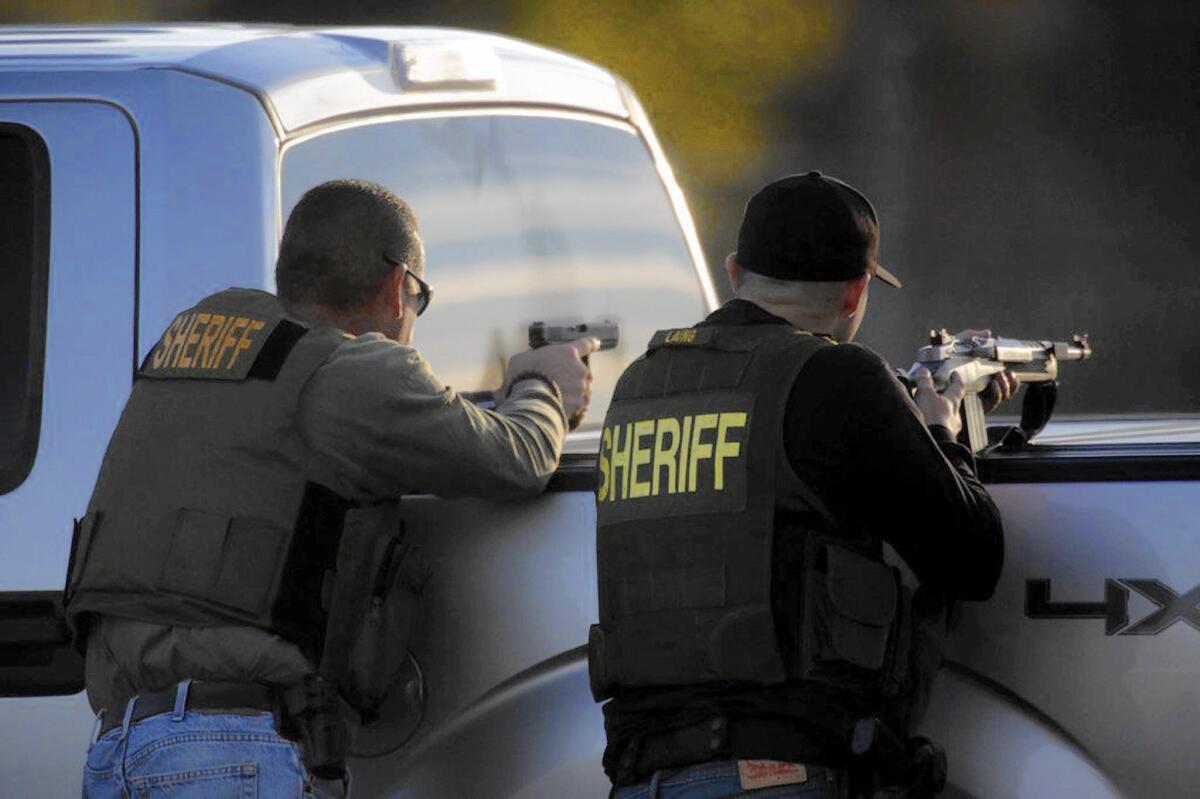Column: Police got it right in San Bernardino; not so in other deadly cases

If there was any bright spot in the circumstances surrounding last week’s massacre in San Bernardino, it was the performance of law enforcement officers.
Police officers, sheriff’s deputies and federal agents worked together to stop the killers, search the area and investigate the circumstances.
From the start, San Bernardino officers drew on lessons learned from previous mass shootings. They didn’t hang back as officers had in Columbine, when two students killed 13 people in a high school siege that went on for almost an hour.
FULL COVERAGE: San Bernardino shooting | Live updates
San Bernardino officers quickly assembled a team that rushed in, ready to confront the shooters. The hunt for the killers was thorough and transparent. Even through a raging gun battle that left both suspects dead, the police stayed calm and kept residents safe and the public informed.
It was a display of professionalism that we ought to publicly applaud. It highlighted the importance of sound tactics and the value of history.
If police departments around the country took those elements more seriously, we might not have so many high-profile incidents in which tactical errors lead to civilian deaths, put officers at risk and diminish public confidence in law enforcement.
•
Exhibit A is the death of Kendrec McDade, who was killed by Pasadena officers after a 911 caller falsely reported that McDade had a gun. The shooting of the unarmed 19-year-old was ruled justifiable by the department and the Los Angeles County district attorney.
But a report by an independent review commission of law enforcement officials blasted the officers for several egregious tactical blunders and faulted the Pasadena department for its shoddy investigation.
The officers’ mistakes put them in “a precarious position” that left them little choice but to try to shoot their way out, the report said. One officer jumped out of the patrol car to chase McDade without telling his partner — who then drew his gun while driving, crashed into a brick wall and made the “potentially disastrous mistake” of getting out of the patrol car without putting it in park.
The shooting occurred more than three years ago. But the report was made public, by court order, only last month. The police union battled its release to protect the officers’ “privacy rights.” And the department brass didn’t want us to see it — probably because it shows how little they cared about making the tragedy a teachable moment.
That’s not uncommon in the insular culture of law enforcement. But it’s exactly the wrong approach, particularly in an era of cellphone videos and patrol car cameras that provide an objective record and plenty of public fodder.
Some departments recognize that; they have made frequent tactical refreshers a part of their community policing plans.
In Richmond, police supervisors meet regularly to dissect every use-of-force case. They incorporate lessons from those incidents into role-playing sessions that officers attend every few months. There they learn to de-escalate tense situations and practice making split-second use-of-force choices.
The homicide rate in the Northern California city is at its lowest in 33 years. Officer-involved shootings rarely occur
“There are a million different decisions that go into getting you into that [shoot or don’t shoot] situation,” said UCLA professor Phillip Atiba Goff, who studies departments around the country as head of the Center for Policing Equity. “You want the kind of tactical training that sets you up so you don’t wind up in that place.”
•
The tactical flaws cited in the Pasadena report echo a theme in controversial shootings nationwide: Police fire in response to dangerous situations that their own choices helped create.
The Pasadena department concluded that the officers did the best they could in a chaotic situation.
But that chaos existed because the officers’ actions “were not congruent with principles of officer safety,” the review panel found.
You could say the same about the case of Ezell Ford, who was shot to death last year by LAPD officers who suspected he might be carrying drugs. Ford was unarmed, but was shot during what an officer said was a struggle for his gun — a struggle that might not have occurred, the Police Commission found, had the officer not grabbed Ford and tried to wrestle him to the ground.
Or the case of Tamir Rice, the 12-year-old shot to death last year at a park in Cleveland by officers responding to a 911 call about a man with a gun. A rookie officer began firing at Tamir before his patrol car even came to a stop. It took him all of two seconds to decide the boy was a threat. Tamir died with a toy gun tucked in his pants. The officer who killed him said he had no choice.
That’s the refrain in many use-of-force cases: We focus on that moment when officer and suspect connect.
But tactics matter. Those encounters are choreographed by the choices that both sides make — and those choices are too important to be left to adrenaline or a hunch.
Twitter: @SandyBanksLAT
ALSO
Should people on the no-fly list be able to buy guns? Yes.
Trump’s latest howler on Muslims isn’t funny; it’s poisonous
Obama said the right things about terrorism, but he waited too long to say them
More to Read
Start your day right
Sign up for Essential California for news, features and recommendations from the L.A. Times and beyond in your inbox six days a week.
You may occasionally receive promotional content from the Los Angeles Times.







